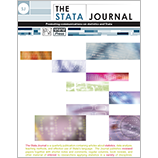Parametric frailty and shared frailty survival models
Roberto G. Gutierrez
Stata Corporation
|
Abstract. Frailty models are the survival data analog to regression models, which
account for heterogeneity and random effects. A frailty is a latent
multiplicative effect on the hazard function and is assumed to have unit
mean and variance θ, which is estimated along with the other
model parameters. A frailty model is an heterogeneity model where the
frailties are assumed to be individual- or spell-specific. A shared frailty
model is a random effects model where the frailties are common (or shared)
among groups of individuals or spells and are randomly distributed across
groups. Parametric frailty models were made available in Stata with the
release of Stata 7, while parametric shared frailty models were made
available in a recent series of updates. This article serves as a primer to
those fitting parametric frailty models in Stata via the streg
command. Frailty models are compared to shared frailty models, and both are
shown to be equivalent in certain situations. The user-specified form of the
distribution of the frailties (whether gamma or inverse Gaussian) is shown
to subtly affect the interpretation of the results. Methods for obtaining
predictions that are either conditional or unconditional on the frailty are
discussed. An example that analyzes the time to recurrence of infection
after catheter insertion in kidney patients is studied.
View all articles by this author:
Roberto G. Gutierrez
View all articles with these keywords:
parametric survival analysis, frailty, random effects, overdispersion, heterogeneity
Download citation: BibTeX RIS
Download citation and abstract: BibTeX RIS
|
